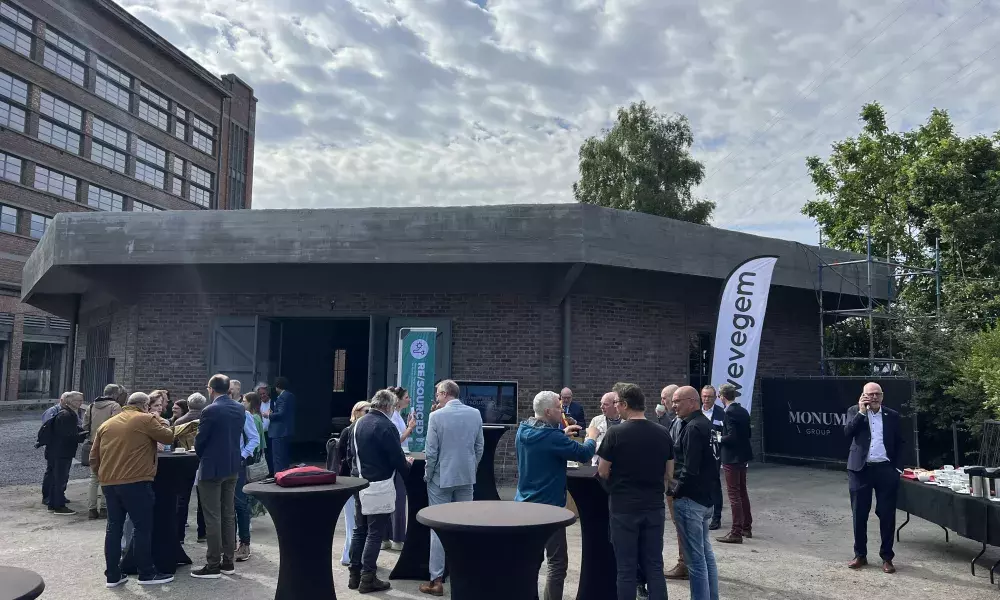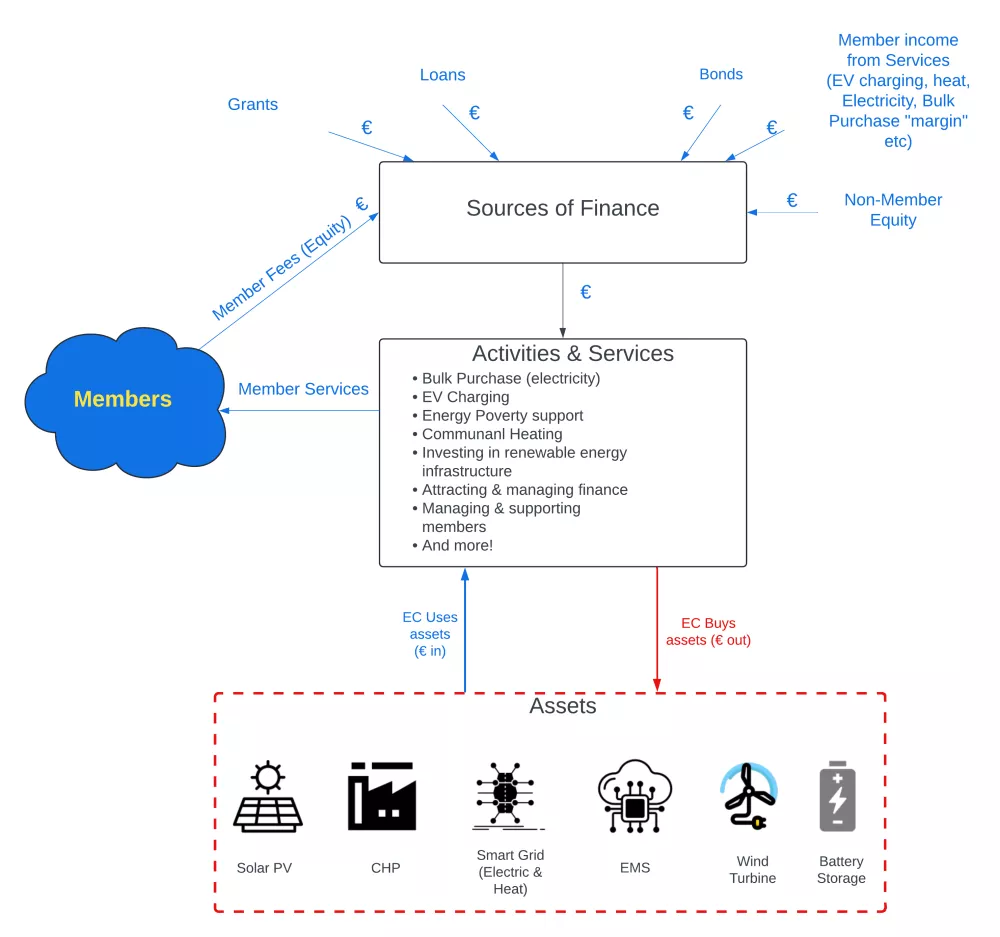
This article describes the challenge in designing Energy Communities that are commercially viable and identifies activities that can be revenue generating. It also identifies a specific challenge for RE/SOURCED which planned to transfer a significant circular renewable energy system, in a commercially sustainable way, to a newly-formed Energy Community
The original RE/SOURCED concept aimed to create a local renewable energy “system” that would generate renewable energy and distribute it to households and businesses located on the Transfo site. The site is unusual in that it has a mix of social and private residential housing, a range of outdoor amenities and a newly renovated office block (in the restored power station building).
The original concept assumed that if excess electricity was generated on site, it would be "exported" from the Transfo grid to the public grid while if there was insufficient electricity produced, the system would “import” electricity from the public grid. Consumers (households and businesses) would receive a single bill showing how much energy they used and the proportion coming from the public and Transfo grids.
At a project level, RE/SOURCED would create the system comprising:
- An array of Solar PV panels and other (smaller) generation
- A Combined Heat and Power (CHP) system generating heat and some electricity
- Electricity storage using second life batteries
- A smart DC Grid
- A single point of common coupling between the RE/SOURCED system and the public grid allowing electricity to be “sold” to the grid or “bought” from it
- Infrastructure to convert the DC electricity produced by the Solar PV arrays to AC
- A computerised, cloud-based energy management system (EMS) to enable the operation of the grid to be optimised.
In addition, a wind turbine was to be installed on-site but recent changes to the rules governing the proximity of energy generating devices from existing power-line infrastructure prevented this from being possible (the minimum allowable distance was increased and the Transfo turbine would have been too close). An Energy Community would be created to allow Transfo’s households and businesses to be actively engaged in owning and operating the system in a way that would best suit the interests of their community.
The RE/SOURCED project partners anticipated that the system’s assets would be transferred to the Energy Community (effectively an asset transfer) and that the Community would use the revenue generated by the operation of the system to repay this cost. Implicitly, it was anticipated that this asset transfer would be an initial liability for the Energy Community but that as the debt was paid off, the Energy Community would own an asset of significant value and one that could be developed, expanded and enhanced over time (for example, through the addition of new renewable energy generating capacity).
As with all pioneering projects of this kind, things did not proceed wholly as planned.
Energy Communities as a concept were introduced through the Clean Energy for All Europeans package (see explanation here) with two different classes of Energy Community being available (Citizens Energy Communities and Renewable Energy Communities).
Each member state has adopted the Directives within the context of the member state’s energy and electricity existing legislation. Some Member states have not differentiated between Citizens Energy Communities and Renewable Energy Communities.
The adoption of the Directives by Member states may not always make an energy community an attractive route for citizen and community engagement. This is the case with RE/SOURCED where the Flemish Energy Decree provides very little incentive to create an Energy Community. Indeed the Decree’s requirements seem to make it impossible for the RE/SOURCED Energy Community to operate effectively (within the spirit originally intended by the Energy Directives) as it makes it very difficult for residents and businesses at a location to benefit from the sharing of energy that is produced at that location.
This context within Flanders, specifically the limitations on how energy might be shared and distributed on the site at which it is generated, has a commercial impact on the business model for the RE/SOURCED Energy Community. Specifically the original idea of transferring the energy amongst the households and businesses at Transfo was not legally allowable.
This significantly limits how the RE/SOURCED Energy Community can generate revenue as its only viable “sharing” route is to “sell” the electricity through EV charging stations – this is the principle source of accessible income (the second being selling the surplus energy to an energy supplier).
But being not-for-profit organisations, do Energy Communities need to be commercially sustainable? In a word, Yes!

Business models describe the way an organisation can operate in a financially sustainable way. To put it very simply, a financially sustainable organisation is one whose income exceeds the amount it spends on its activities, assets, loan interest and resources.
To continue operating, an Energy Community must be commercially sustainable – it must attract more funding into the organisation than it spends.
Across the EU, most Energy Communities’ start-up income is derived from the private investments of their members – members pay a fee to join the Community. This can be a one-off fee (a single payment) or a monthly/yearly contribution but the key issue is that the members provide funds that can be used to purchase equipment and/or deliver services that their members desire. Services are usually commercially beneficial for their members, but this is not always the case - some Energy Communities use their surpluses to support environmental projects elsewhere or to help disadvantaged groups (e.g. those in energy poverty). In summary, the more members and Energy Community has, the more start-up income available. Given the RE/SOURCED Energy Community has relatively few members (limited to the number of households and businesses on site), the amount of funds the start-up Energy Community could raise was lower.
Providing they can generate sufficient income, Energy Communities can support a potentially very broad range of activities, including:
- Building renewable energy generation capacity
- Buying renewable energy on the open market from other providers and making this available to members
- Selling energy to its members
- Bulk purchase of energy on the open market
- Supporting energy conservation activities
- Helping to support members in energy poverty
- Providing EV charging – this can be an important source of revenue for ECs
- Providing district/communal heating
- Attracting/managing finance through
- Equity from members
- Equity from non-members
- Loans from investors, banks or Government
- Grants from Government
- Bond issues.
To fund these activities, the Energy Community must generate income – this income can come from:
- Members’ joining/membership fees and on-going contributions
- Revenue from energy produced by the EC (e.g. Solar PV)
- Bulk Purchase “margin” – if an Energy Community has a large number of members, it can demand more favourable tariffs from energy suppliers and this allows it to provide energy at a discount to members – usually, Energy Communities charge their members a little more than they pay the producer so they make a “margin” that creates a revenue stream
- Financial contributions by members to specific energy saving projects
- “Sales” of EV charging and district/communal heating capacity – this is most profitable when the Energy Community can use electricity it has generated/stored rather than buying-in electricity from the public grid (always more expensive)
- Non-repayable grants
- Providing energy services to its members, providing flexibility services to the energy grid and the energy suppliers, etc.
There are risks that must be considered when preparing business cases for Energy Communities. The energy market is dynamic with new entrants emerging, established operators withdrawing and constantly changing tariffs. Thus, all Energy Community business models must be flexible if they are to be sufficiently commercially robust to accommodate changes in market dynamics. Energy Communities should not accept “lock-in” tariffs that fix the amount their members must pay for fixed periods – any time-based arrangements should be indexed to market prices or comparable tariffs so that if a new (lower) tariff is introduced, Energy Community members are not left paying more than they would if buying their energy in the open market.
In addition to rapidly changing tariff structures, there can be changes to market conditions, energy crises, changing regulations etc all of which can fundamentally alter the viability of the business case. These changes can occur with little warning and their effect on the viability of an Energy Community can be detrimental.
Separately, the new role of Energy Communities as defined in the Energy Directives and the new types of innovative activities they are open to pursue also come with risks. Taking RE/SOURCED as an example, managing a smart grid is very innovative but it comes with significant uncertainty. As much of an Energy Community's work can be pioneering (R&D or novel application of technologies), it is difficult to predict the outcome and likely successes accurately when planning their design.
For RE/SOURCED, it was planned that the Smart Grid equipment and installations (the system “assets”) would be transferred to a new RE/SOURCED Energy Community. This Energy Community would have to “pay” Leiedal Intermunicipal Association to acquire the system or Leiedal could find a "transfer mechanism" where the value of the equipment is treated as a loan to the Energy Community which the Community then pays back over time. When designing the RE/SOURCED project, it was anticipated that Energy Communities' activities set out in the Energy Directives would be fully supported in Flanders – as explained above, the detail of the Flemish Energy Decree prevent the anticipated RE/SOURCED business model concept from being adopted. This greatly limited the options open to the Energy Community to generate income.
Due to the combination of the limitations imposed by the Flemish Energy Decree, the relatively small pool of potential members and the small amount of energy that would be allowed to be shared, RE/SOURCED had to adapt. In the event Leiedal Intermunicipal Association (as the UIA project's Lead Partner) did two things:
- It decided to retain ownership of the DC Smart Grid – at least in the short term thereby reducing the risk of transferring the asset to a newly formed Energy Community that might struggle to service the debt requirements
- It looked for an existing Energy Community or cooperative who could manage the Smart Grid and engage with members – households and businesses at Transfo would join this Energy Community organisation.
This approach ensured that Transfo users had the opportunity to benefit from Energy Community membership while also protecting UIA’s investment in creating the Smart Grid asset.
As with many other aspects of the project, the RE/SOURCED partners had to be pragmatic. It could not have been foreseen that the adoption of the relevant Energy Directives in Flanders (which has only been finalised recently) would constrain energy sharing to the extent now set out in the Flemish Energy Decree. This limited the ability of the Energy Community to generate the income necessary to pay Leiedal Intermunicipal Association for the acquisition of the Smart Grid asset.
Separately, engaging an established Energy Community reduces the commercial and operational risk of the project going forward. It also strengthens the Energy Community as their membership increases – this is especially relevant for RE/SOURCED as Leiedal is retaining the ownership of the asset so that the recipient Energy Community does not incur a capital liability unless it is financially strong enough to make the purchase. This is good practice.
About this resource
The Urban Innovative Actions (UIA) is a European Union initiative that provided funding to urban areas across Europe to test new and unproven solutions to urban challenges. The initiative had a total ERDF budget of €372 million for 2014-2020.
Similar content



